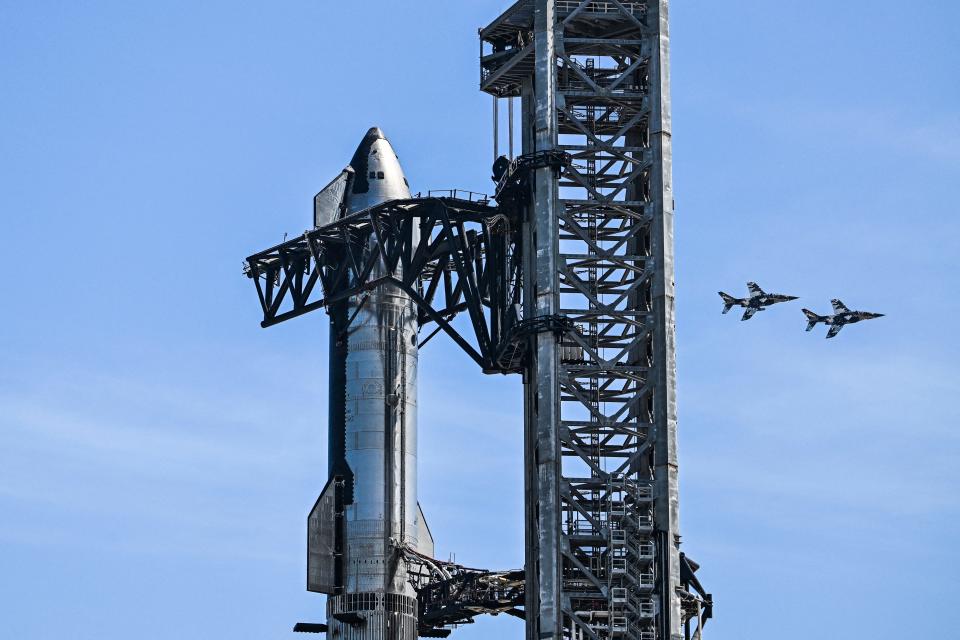SpaceX Starship KSC environmental study to be discussed at 3 June open houses in Brevard
SpaceX Starship-Super Heavy launches from two nearby sites on the Space Coast continue proceeding to reality: Federal officials are now studying the two-stage mega-rocket's potential environmental impacts at NASA's Kennedy Space Center.
The Federal Aviation Administration is preparing an environmental impact statement that will scrutinize infrastructure supporting up to 44 future Starship-Super Heavy launches per year at pad 39A, which SpaceX leases today for Falcon 9 and Falcon Heavy liftoffs.
SpaceX — which touts Starship-Super Heavy as "the world’s most powerful launch vehicle ever developed" — has already installed a large-scale launch tower here for future use. The FAA environmental study will consider Starship-Super Heavy launches; Super Heavy booster and Starship landings at pad 39A or on drone ships; and expendable Super Heavy booster and Starship landings in the ocean.
Starship: More SpaceX Starship-Super Heavy details revealed for proposed launches at Cape Canaveral
Meanwhile, just to the south, SpaceX officials hope a different Starship-Super Heavy complex starts hosting launches by 2026 at adjacent Cape Canaveral Space Force Station. The Air Force is preparing a Starship environmental impact statement with NASA, the Federal Aviation Administration and Coast Guard. Public meetings occurred in March in Cocoa, Titusville and Cape Canaveral.
"By providing a reusable launch vehicle, SpaceX proposes that the Starship-Super Heavy would deliver efficient access to space and enable cost-effective delivery of cargo and people to the moon and Mars," the FAA project website says.
"Currently, SpaceX is conducting flight tests of the Starship-Super Heavy at Starbase in Boca Chica, Texas, an exclusive use launch site that serves as SpaceX’s primary research, development, and flight test launch facility for the vehicle," the website says.

FAA officials have scheduled a trio of Space Coast open houses and one virtual meeting to collect comments from the public on proposed KSC pad 39A launches. More information:
June 12: Radisson Resort at the Port, 8701 Astronaut Blvd., Cape Canaveral. Two open houses will occur, from 2 p.m. to 4 p.m. and from 6 p.m. to 8 p.m.
June 13: Kennedy Space Center Visitor Complex, Merritt Island. An open house is scheduled from 6 p.m. to 8 p.m.
June 17: Virtual meeting from 6 p.m. to 8 p.m. Officials will provide website and call-in information in advance on the FAA’s SpaceX Starship-Super Heavy KSC project website at faa.gov/space/stakeholder_engagement/spacex_starship_ksc.
The in-person open houses will feature information stations where the FAA will "provide information describing the purpose of the scoping meetings, project schedule, opportunities for public involvement, proposed action and alternatives summary, and environmental resource area summary. Fact sheets will be made available containing similar information," the project website says.
"At any time during the meetings, the public will have the opportunity to provide verbal comments to a court reporter or written comments via a written comment form at one of several commenting stations," the website says.

NASA began construction of pad 39A in 1965 to support the Apollo program. The storied KSC launch complex later supported 82 space shuttle missions. In 2014, NASA entered into a 20-year property agreement with SpaceX.
In September 2019, NASA completed an environmental assessment of future Starship-Super Heavy operations that included construction of a launch mount, liquid methane farm, transport road, deluge water system, landing zone and high-pressure gaseous commodity lines. The assessment found the launches would not have a significant impact on the biological or physical environment.
The scope of that NASA study encompassed about 24 Starship launches per year — but SpaceX now proposes to up to 44, per the FAA. The company also proposes to construct additional launch infrastructure not previously contemplated, launch an advanced design of the Starship-Super Heavy vehicle, and land Super Heavy boosters at pad 39A, the FAA project website says.
At Cape Canaveral Space Force Station, SpaceX prefers to repurpose and take over Launch Complex 37 for Starship operations. That's where United Launch Alliance sent up its last Delta IV Heavy rocket in early April.
A second option at the Space Force installation: Build Launch Complex 50, a new Starship complex, within a 120-acre zone of undeveloped land just north of LC-37 off Samuel E. Phillips Parkway.
Starship landings are no longer proposed at Landing Zone 1 at Cape Canaveral Space Force Station, per the FAA.
For the latest news from Cape Canaveral Space Force Station and NASA's Kennedy Space Center, visit floridatoday.com/space.
Rick Neale is a Space Reporter at FLORIDA TODAY. Contact Neale at Rneale@floridatoday.com. Twitter/X: @RickNeale1
This article originally appeared on Florida Today: SpaceX gearing up to launch Starships from NASA's Kennedy Space Center

